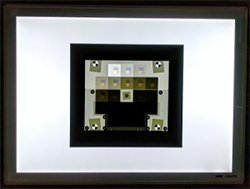
Abstract
The dynamic range of recent HDR image sensors, defined as the range of exposure between saturation and 0 dB SNR, can be extremely high: 120 dB or more. But the dynamic range of real imaging systems is limited by veiling glare (flare light), arising from reflections inside the lens, and hence rarely approaches this level.Veiling glare measurements, such as ISO 18844, made with black cavities on white fields, result in large numbers that are difficult to relate to dynamic range. Camera dynamic range is typically measured from grayscale charts, where veiling glare depends on the design and layout of the chart, leading to inconsistent results.
We discuss the interaction between veiling glare and dynamic range measurements and the need for standardization of test conditions. We also propose a new dynamic range definition and a new test chart design for directly measuring the visibility of low contrast features over a wide range of scene brightness, which is important for real-world applications, especially in the automotive and security industries where the visibility of people and obstacles in shadow regions is critical. Unlike standard grayscale charts, the new test chart provides meaningful results when tone mapping is applied.
Presented at EI2018 IQSP Conference, Monday January 29, 2018
Author: Norman Koren

